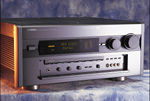 Flagship is one of those words like ultimate and reference that just can't seem to get any respect these days. The next time we see last year's "ultimate" product superseded by this year's "improved" model, I think we should all complain to the manufacturer.
Flagship is one of those words like ultimate and reference that just can't seem to get any respect these days. The next time we see last year's "ultimate" product superseded by this year's "improved" model, I think we should all complain to the manufacturer.Yamaha, however, could never be accused of hyperbole when it comes to their new flagship receiver, the RX-V1. Loaded with features, this model takes all of Yamaha's experience with DSP soundfield re-creation and condenses it into a receiver of exceptional flexibility and control. I say it's condensed, but only up to a point because, at 61 pounds, this receiver is quite a beast. Its appearance stays true to Yamaha's normal smooth and clean style, with most of the controls hidden behind a flip-down door.
The rear panel is about as populated with connectors as any product I've ever seen— with seven A/V inputs, including three VCR loops (there's also an A/V input on the front). To handle component video sources, there's a three-input switcher with one output. Additionally, there are three audio-only inputs with two tape loops, a phono input, and a 5.1-channel input. On the digital side of things, there are seven optical and three coaxial inputs, an AC-3 RF input, and an optical record output. Other outputs include a full complement of preamp outputs, including stereo and mono subwoofer connections, no less than 10 speaker outputs, two monitor outputs, and a second-zone A/V output. All A/V connections except the second-zone output include both S-video and composite connections. Control is important with a product as versatile as this, so Yamaha has included separate IR inputs for each zone, a repeater output, an RS-232 interface, and a 5-volt trigger output.
Now, some of you may be scratching your head at the thought of 10 speaker outputs. There are two sets of outputs for the main left and right speakers, but that still leaves you with eight individual channels of amplification. Sure, there are the usual five channels that we're all familiar with, but Yamaha has added a pair of front surround speakers and a rear center speaker, which poses an interesting problem. Many people find it difficult to position five speakers plus a subwoofer, and now we're asking them to add another pair of speakers above and outside the main left and right, as well as a speaker behind the listening position called the surround back. This surround back speaker could be particularly difficult because many people have their sofa up against the wall. In my room, there's a pair of French doors behind the sofa, and the surround back speaker wound up blocking part of the doorway, which is fine for the review period but not much longer.
Setup is fairly straightforward once you've run all those speaker cables, with onscreen displays that guide you through most of the process. Curiously, while there's an easy provision to set a delay for the center and surround back speakers relative to the main front and left/right surround speakers, the front-to-rear delay must be set individually for each surround mode. Bass management is quite comprehensive and will, among other things, let you send the main left and right channels' bass information to both the sub and the main speakers simultaneously. There's even a variable low-frequency tone generator to assist in woofer positioning.
The AM/FM tuner allows up to 40 channels to be stored in five subgroups of eight channels each. With a decent antenna, it has fine-sounding, low-noise reception. The remote is a bit less involved than Yamaha's previous offerings. It has both preprogrammed and learning capabilities and can store several macros of up to 10 commands each. One nice touch is that the illumination is limited to the buttons used to control the selected component.
Because of Yamaha's singular approach to surround sound, this receiver is not certified to THX specifications. However, the company has included their own version of Cinema EQ, which compensates for the difference in brightness between a movie theater and your living room. This gives you tremendous control over the system's tonal characteristics, with separate equalization for each channel. Even the headphone output has a surround-simulation program called Silent Cinema that has its own digital equalizer and dynamic-range control, creating an effect similar to Dolby headphones.
The RX-V1 has 54 different soundfield programs, some of which are used primarily with music while others are best with movies. Within each of these preset soundfields, you can adjust several parameters, including the effect level, liveness, and room size. Many of these programs are based on real-world measurements that Yamaha has taken in venues like the Village Vanguard in New York and the Concertgebouw in Amsterdam. Luckily, I've been to several of the venues, which helped me evaluate the effectiveness of the processing.
Yamaha uses LSI chips of their own design operating at an astounding 44 bits, and the results are undeniably impressive.With 110 watts per channel for each of the six main speakers and 35 more for each front surround speaker, there's plenty of power for most applications.
Many people are likely to balk at the thought of spending $3,300 on a receiver; however, if Yamaha were to dump the power-amplifier section and sell this simply as a pre/pro, it would still be an excellent value. Whether it's the right product for you will depend somewhat on your ability to find room for the plethora of speakers needed to get the best results. When fully loaded, this receiver is so flexible and powerful that I'm sure anyone could find a setting that would live up to their highest expectations!